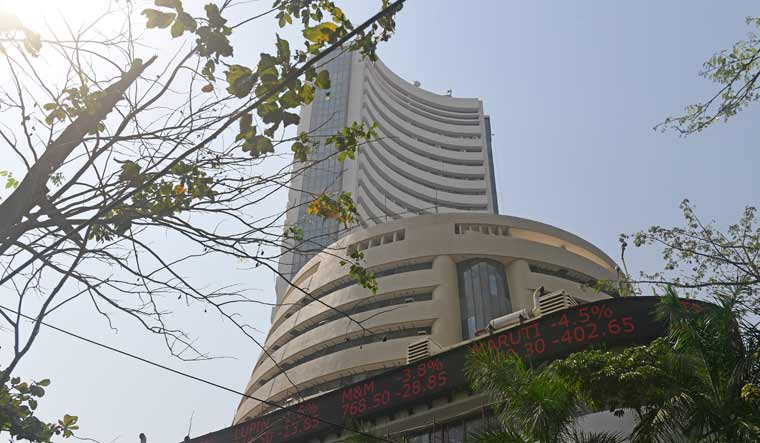Equity markets have rallied sharply over the last six sessions. On the back of expectation that the Narendra Modi-led NDA government will win majority again, the bulls have driven the BSE Sensex up 5.4 per cent to 39,110.21 points as of close on Wednesday, versus 37,114.88 on May 15. In an interaction with THE WEEK, Jyoti Roy, deputy vice president of research at Angel Broking says the market expects the NDA to win 260-280 seats. While the markets could also be happy if the Congress-led UPA wins a majority, one must be prepared for a correction if there is a fractured mandate. Roy is also betting on the Reserve Bank of India cutting interest rates by additionally 0.50 per cent to 0.75 per cent to lift the slowing economy and says banking and consumption stocks should form a major part of one’s equity portfolio.
Excerpts from interview:
We have seen sharp rally post the exit polls. How do you see the markets reacting once election results are announced?
 Jyoti Roy
Jyoti Roy
We probably reacted significantly more than we should have with regards to the US China trade issues. There is still a lot of uncertainty over the election outcome. The base case scenario is that markets are working with incumbent government coming back; probably the NDA getting between 260-280 seats. If you go by that base case scenario, there is not too much margin for error. Markets will be happy even if the UPA gets 250-270 seats. If any of these two national level parties get a majority of their own, the markets will be happy as it will ensure continuity of policy. What markets are scared a bit about is a fragmented government.
There is a slowdown in the economy, which is clearly reflected in the high frequency indicators like auto sales numbers and IIP growth trend, there was negative growth in March. The PMI (purchasing managers index) numbers have also started reflecting the slowdown. So, if you have an adverse election result, then there could be some amount of downside in the market. Election results, from a long-term perspective, will not make much of a difference. But, if an actual blip happens, its going to hurt a lot, especially in the backdrop of the economic slowdown.
What measures do you expect to revive the economy?
With a bit of a slowdown, inflation expectations are likely to go down further. That will open up further elbow room for the RBI to cut rates. We are penciling in another at least 50-75 basis points repo rate cut by the RBI over the next 6-9 months. If the slowdown continues for some more time, there could be scope for some more rate cuts.
How much will only repo rate cuts help the economy?
There are multiple things that need to work for us. A stable government will help us. What’s heartening is if the trend continues to pickup in the GST collections in the last two months. Also, its not only about the interest rate cut, but also about transmission of rates. While banking system credit growth has picked up at 15 per cent, what it doesn’t capture is the shadow banking system, that is NBFCs. Corporates were also raising a lot of money through mutual funds, credit funds. That has also come to a standstill. So, probably, it will require a big monetary stimulus to get the economy out of the slowdown, irrespective of which government comes to power. Once the sentiments improve and animal spirits come back, that itself will give some momentum to the economy. So, it will push IIP from a 0 per cent level to 2-4 per cent mark. Most of the reforms are done, just that you need to keep streamlining them.
In the past two-three years, what we have seen is analysts start with strong earnings expectations, only to be subsequently downgraded. Do the fourth quarter earnings give you any hope of a revival this year?
You start off with 28 per cent and there have been times when you have gone down to 5-10 per cent. This time around, the cut is not going to be probably as steep. The NPA cleanup in banks contributed to a drag in Nifty earnings growth. Over the next three years, not only will their profit normalise, but also see a jump over FY14. The aggregate profit after tax for the three large banks was Rs 31,000 crore, its Rs 3,595 crore now. By, FY21 the profit is expected to increase to Rs 66,000 crore. Banks will drive the next round of earnings growth. We are already seeing it in a couple of large private sector corporate banks. Some of the PSU banks are still saddled with reasonably high level of NPAs. Those things should also normalise over the next couple of quarters.
Is the time ripe then to invest in banking stocks?
India has a growing economy. Financialisation of savings has only started 2-3 years back. So the banking system will keep on growing. There is a big shift happening from the informal sector like moneylenders, which you see is reflected in your micro-finance growth. Some of the new banks have a very strong rural focus and they will keep growing over there. The way the Indian economy is structured, banking and consumption will form 70 per cent to 80 per cent of your portfolio. There is no two way about it.
Aren’t valuations in consumer stocks expensive?
Consumption is a very broad space. Not just FMCG, but even consumer discretionary, retailing, auto… FMCG valuations are expensive, but they will always be so. You will never see these larger FMCG companies correcting 40-50 per cent. So, 15-20 per cent correction is what you can expect in them. More than price correction, you will probably see more time correction in the consumption space. You have to use this correction to buy into these stocks.
Any other sectors that look good?
Automobile companies have a low base, so the second half of the year should be good for them. There will be a lot of pre-buying that is going to happen (before BS-VI regulations come into effect from April 1, 2020), because the price differential is expected to increase significantly. With infrastructure growing and hopefully economy also picking up, we should see more growth in commercial vehicle space. Stock prices have also corrected. We don’t see super normal earnings growth anywhere, although there will be stock specific exceptions. Rural focussed stocks should do well. NBFC could also be a interesting space, once the credit crunch eases. So, while 70-80 per cent of the portfolio will be into banking and consumption stocks, the balance will be based on stock picking. There will be some stocks in your portfolio purely based on their merit. They could be from any sector, pharma, or information technology or chemicals.



